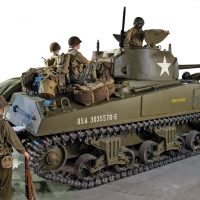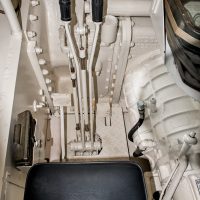SCM Analysis
Detailing
| Vehicle: | 1944 Chrysler M4A4 Sherman Tank |
| Years Produced: | 1942–43 |
| Number Produced: | 7,499 |
| Original List Price: | N/A |
| SCM Valuation: | $275,000–$450,000 |
| Tune Up Cost: | $2,000 |
| Distributor Caps: | N/A (sealed magneto ignition, Ford GAA) |
| Chassis Number Location: | Builder’s plate on the inside of the hull, alongside the driver’s left leg |
| Engine Number Location: | Tag on the front (water pump end) of the engine block between the cylinder heads (Ford GAA) |
| Club Info: | Military Vehicle Preservation Association |
| Website: | http://www.mvpa.org |
| Alternatives: | 1940–43 M3 Stuart medium tank, 1942–44 Ford M8 Greyhound light armored car, 1942–45 White/Autocar/Diamond T M2/M3 half-track |
| Investment Grade: | B |
This tank, Lot 46, sold for $389,767, including buyer’s premium, at Artcurial’s Normandy Tank Museum Auction in Catz, Normandy, France, on September 18, 2016.
If one had to name five pieces of equipment that played a huge role in the Allied victory in World War II, there’s no doubt that the Sherman tank would be on the list. It may not have been the best tank on the battlefield, but it was pretty good. More importantly, there were a lot of them (more than 50,000 were built).
This was the U.S. Army’s main battle tank in the European Theater of Operations, and most of our allies — France, Great Britain and even Russia — rode Lend-Lease Sherman tanks into battle.
A major problem during the war was that everyone wanted Sherman tanks as fast as they could get them — and right away. Tanks dominated World War II battlefields.
Assembling victory
Many U.S. companies had contracts to build Sherman tanks, including Baldwin Locomotive, American Locomotive, Lima Locomotive, Pressed Steel Car, Pullman-Standard, Pacific Car & Foundry, Federal Machine, Ford, GM’s Fisher Body Division and Chrysler.
So, with all those assembly lines humming, what was the problem?
The weak link in the supply chain was engine availability. The Continental R975 9-cylinder radial engine used in the original M4 and M4A1 was an aircraft engine. We needed bombers and fighters as much as we did tanks, so those radial engines were in short supply.
Detroit came to the rescue — and fast.
While General Motors developed the M4A2, using a pair of their 6-71 6-cylinder diesel engines, Ford developed what became the eventual U.S. Army standard M4A3. It was powered by the 1,100-ci aluminum-block gasoline V8 they developed, called the GAA. Used exclusively for tanks, it was based on their work a year earlier for a V12 aircraft engine contract that was canceled.
Another Sherman for our allies
To increase overall Sherman production for our allies under the Lend-Lease agreement, Chrysler — who operated the Detroit Tank Arsenal — developed the M4A4 variant.
While it was configured similarly to the basic M4, the major difference was propulsion. Chrysler came up with one of the wildest examples of Yankee ingenuity during the war — the A57 powerplant. It was a 30-cylinder radial engine formed from five 250-ci Chrysler inline flathead 6-cylinder automotive engines geared together and running in concert.
To package this massive contraption into a Sherman, the M4A4 has a longer hull aft of the turret — plus a longer track and longer ground contact patch. As such, the spacing of the bogey wheels is wider than on any other Sherman.
Our subject tank is one of these M4A4 models — well, sort of.
The wrong engine
While our subject tank presents well cosmetically, and it is stated that it runs out fine, there are a few things that don’t add up. Unlike the standard specification of the genre, this example is powered with a M4A3’s Ford GAA V8 rather than a Chrysler A57.
The auction description said: “The engine is as new and is certainly the best in terms of torque, flexibility and reliability” —with no mention that the tank now has the wrong engine.
Yet our subject Sherman tank is undeniably an M4A4, as it has the longer hull and wider spacing of the bogey wheels.
This Lend-Lease tank — it probably fought under the French or British flags — was repainted with U.S. Army unit markings. So it had two strikes against it when it comes to originality.
The multi-bank Chrysler A57 is exceptionally rare — and quite a bear to set up. Think of doing a tune-up on five engines at once — and only one is relatively easy to reach and operating in the way that God and Walter P. Chrysler had originally intended.
There is at least one Sherman tank that still runs on an A57 engine. I know of two more A57 engines that were removed from tanks and are display pieces. One is in a private collection that I personally inspected at the time I wrote this piece. The other is in the Walter P. Chrysler Museum in Auburn Hills, MI.
It’s easy to figure that the swap for the far more prevalent (yet hardly falling out of trees) Ford GAA V8 was done to make our subject tank a better-functioning vehicle — regardless if it was done in depot maintenance after World War II or when it was last restored.
Did the engine change reduce the value? For most military vehicle collectors it does. Yet for collectors who want a functional, easily maintained runner, the engine swap may be considered a bonus — but not at a financial premium.
A softer — but not tanking — market
All types of World War II military vehicles are still very popular to collect — including armor. So the final price here is a touch soft.
Looking closer, the buyer was an American, so there are several issues — and lots of expensive shipping — to get this beast back to the United States.
There are several active World War II re-enactment groups in Europe, and one of them probably would have scooped up our subject tank if they had the money. Our subject tank meets their mission profile of an authentic-looking, good-runner tank.
The seller — The Normandy Tank Museum — was closing and selling out, which means this tank was going to sell in any case.
I suspect this tank, which was recently restored and added to the collection, returned a minimal gain to the museum. Considering the engine change, this was a market-correct price for when and where this tank had tracks on the ground. ♦
(Introductory description courtesy of Artcurial Motorcars.)

